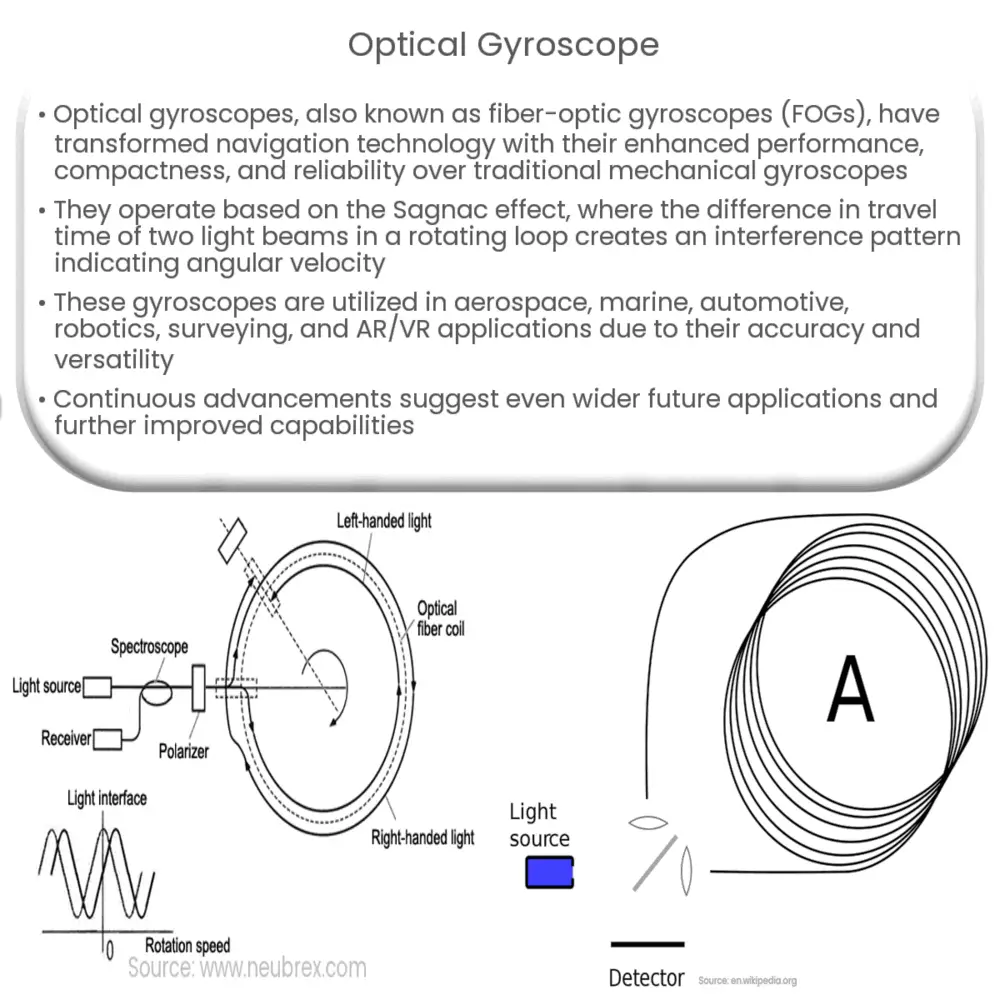Optical gyroscopes use light interference to measure angular velocity, offering high accuracy, reliability, and versatility in navigation applications.

Optical Gyroscope: A Revolution in Navigation Technology
Introduction
Optical gyroscopes, also known as fiber-optic gyroscopes (FOGs), are advanced navigation devices that employ the principles of optics and interferometry to measure angular velocity. They have revolutionized the field of navigation technology by offering enhanced performance, reduced size and weight, and increased reliability compared to their traditional mechanical counterparts. In this article, we will explore the working principle of optical gyroscopes, their advantages, and applications in various industries.
Working Principle of Optical Gyroscope
The core of an optical gyroscope is the Sagnac effect, a phenomenon named after the French physicist Georges Sagnac. The Sagnac effect occurs when two light beams travel in opposite directions along a closed-loop path, such as a coil of optical fiber. When the loop is stationary, the two light beams will travel the same distance and take the same time to complete a full round. However, when the loop rotates, the beam traveling in the direction of rotation will have to travel a longer distance and thus take a longer time to complete the round, while the beam traveling against the rotation will have a shorter path and a shorter travel time. The difference in the travel time of the two beams creates an interference pattern, which is proportional to the angular velocity of the loop.
Advantages of Optical Gyroscopes
Optical gyroscopes offer several advantages over traditional mechanical gyroscopes. Some of these benefits include:
- High accuracy: Optical gyroscopes are capable of measuring very small changes in angular velocity, making them ideal for precision navigation applications.
- Reliability: Since there are no moving parts in an optical gyroscope, the device is less prone to wear and tear, providing a longer operational lifespan.
- Compactness: The use of optical fibers allows for a significant reduction in the size and weight of the gyroscope, making it suitable for integration into smaller systems and devices.
- Wide dynamic range: Optical gyroscopes can operate over a wide range of angular velocities, making them adaptable to various applications.
- Immunity to external influences: FOGs are less sensitive to environmental factors such as temperature and vibration, which ensures stable performance in harsh conditions.
Applications of Optical Gyroscopes
Thanks to their exceptional performance and versatility, optical gyroscopes have found applications in a variety of fields:
- Aerospace: Inertial navigation systems in aircraft and spacecraft rely on optical gyroscopes to provide accurate attitude and heading information.
- Marine: Ships and submarines use optical gyroscopes for precision navigation and stabilization of onboard equipment.
- Automotive: Optical gyroscopes are used in advanced driver assistance systems (ADAS) and autonomous vehicles for accurate position tracking and vehicle control.
- Robotics: Robotic systems employ optical gyroscopes for precise movement control, ensuring stability and accurate navigation during operation.
- Surveying and mapping: Geodetic surveying and remote sensing equipment utilize optical gyroscopes for precise orientation and stabilization of the sensors.
- Virtual and augmented reality: Optical gyroscopes play a critical role in head tracking and motion control for immersive virtual reality (VR) and augmented reality (AR) experiences.
Future Prospects
With continuous advancements in optical technology and materials science, optical gyroscopes are expected to become even more accurate, compact, and affordable in the future. This will lead to their increased adoption in a wide array of applications, from consumer electronics to military systems.
Researchers are also exploring novel gyroscope designs, such as atom interferometers and optical microresonators, which have the potential to further enhance the performance and reduce the size of optical gyroscopes. These cutting-edge technologies could pave the way for a new generation of navigation devices with unparalleled capabilities.
Conclusion
Optical gyroscopes have revolutionized the field of navigation technology by offering a combination of high accuracy, reliability, and compactness. Their versatility has led to their widespread adoption in various industries, including aerospace, marine, automotive, robotics, surveying and mapping, and virtual and augmented reality. As the technology continues to advance, optical gyroscopes are expected to play an even more significant role in the future of navigation and motion sensing systems, leading to improved performance and greater application possibilities across different sectors.

